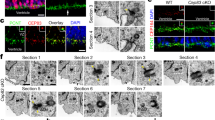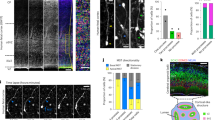Abstract
Asymmetric divisions of radial glia progenitors produce self-renewing radial glia and differentiating cells simultaneously in the ventricular zone (VZ) of the developing neocortex. Whereas differentiating cells leave the VZ to constitute the future neocortex, renewing radial glia progenitors stay in the VZ for subsequent divisions. The differential behaviour of progenitors and their differentiating progeny is essential for neocortical development; however, the mechanisms that ensure these behavioural differences are unclear. Here we show that asymmetric centrosome inheritance regulates the differential behaviour of renewing progenitors and their differentiating progeny in the embryonic mouse neocortex. Centrosome duplication in dividing radial glia progenitors generates a pair of centrosomes with differently aged mother centrioles. During peak phases of neurogenesis, the centrosome retaining the old mother centriole stays in the VZ and is preferentially inherited by radial glia progenitors, whereas the centrosome containing the new mother centriole mostly leaves the VZ and is largely associated with differentiating cells. Removal of ninein, a mature centriole-specific protein, disrupts the asymmetric segregation and inheritance of the centrosome and causes premature depletion of progenitors from the VZ. These results indicate that preferential inheritance of the centrosome with the mature older mother centriole is required for maintaining radial glia progenitors in the developing mammalian neocortex.
This is a preview of subscription content, access via your institution
Access options
Subscribe to this journal
Receive 51 print issues and online access
$199.00 per year
only $3.90 per issue
Buy this article
- Purchase on Springer Link
- Instant access to full article PDF
Prices may be subject to local taxes which are calculated during checkout





Similar content being viewed by others
References
Miyata, T., Kawaguchi, A., Okano, H. & Ogawa, M. Asymmetric inheritance of radial glial fibers by cortical neurons. Neuron 31, 727–741 (2001)
Noctor, S. C., Flint, A. C., Weissman, T. A., Dammerman, R. S. & Kriegstein, A. R. Neurons derived from radial glial cells establish radial units in neocortex. Nature 409, 714–720 (2001)
Malatesta, P., Hartfuss, E. & Gotz, M. Isolation of radial glial cells by fluorescent-activated cell sorting reveals a neuronal lineage. Development 127, 5253–5263 (2000)
Rakic, P. Elusive radial glial cells: historical and evolutionary perspective. Glia 43, 19–32 (2003)
Miyata, T. et al. Asymmetric production of surface-dividing and non-surface-dividing cortical progenitor cells. Development 131, 3133–3145 (2004)
Noctor, S. C., Martinez-Cerdeno, V., Ivic, L. & Kriegstein, A. R. Cortical neurons arise in symmetric and asymmetric division zones and migrate through specific phases. Nature Neurosci. 7, 136–144 (2004)
Chenn, A. & McConnell, S. K. Cleavage orientation and the asymmetric inheritance of Notch1 immunoreactivity in mammalian neurogenesis. Cell 82, 631–641 (1995)
Noctor, S. C., Martinez-Cerdeno, V. & Kriegstein, A. R. Distinct behaviors of neural stem and progenitor cells underlie cortical neurogenesis. J. Comp. Neurol. 508, 28–44 (2008)
Bornens, M. Centrosome composition and microtubule anchoring mechanisms. Curr. Opin. Cell Biol. 14, 25–34 (2002)
Doxsey, S., McCollum, D. & Theurkauf, W. Centrosomes in cellular regulation. Annu. Rev. Cell Dev. Biol. 21, 411–434 (2005)
Xie, Z. et al. Cep120 and TACCs control interkinetic nuclear migration and the neural progenitor pool. Neuron 56, 79–93 (2007)
Tsai, J. W., Bremner, K. H. & Vallee, R. B. Dual subcellular roles for LIS1 and dynein in radial neuronal migration in live brain tissue. Nature Neurosci. 10, 970–979 (2007)
Solecki, D. J., Model, L., Gaetz, J., Kapoor, T. M. & Hatten, M. E. Par6α signaling controls glial-guided neuronal migration. Nature Neurosci. 7, 1195–1203 (2004)
Meraldi, P. & Nigg, E. A. The centrosome cycle. FEBS Lett. 521, 9–13 (2002)
Delattre, M. & Gonczy, P. The arithmetic of centrosome biogenesis. J. Cell Sci. 117, 1619–1630 (2004)
Lange, B. M. & Gull, K. A molecular marker for centriole maturation in the mammalian cell cycle. J. Cell Biol. 130, 919–927 (1995)
Nakagawa, Y., Yamane, Y., Okanoue, T., Tsukita, S. & Tsukita, S. Outer dense fiber 2 is a widespread centrosome scaffold component preferentially associated with mother centrioles: its identification from isolated centrosomes. Mol. Biol. Cell 12, 1687–1697 (2001)
Bouckson-Castaing, V. et al. Molecular characterisation of ninein, a new coiled-coil protein of the centrosome. J. Cell Sci. 109, 179–190 (1996)
Ou, Y. Y., Mack, G. J., Zhang, M. & Rattner, J. B. CEP110 and ninein are located in a specific domain of the centrosome associated with centrosome maturation. J. Cell Sci. 115, 1825–1835 (2002)
Piel, M., Meyer, P., Khodjakov, A., Rieder, C. L. & Bornens, M. The respective contributions of the mother and daughter centrioles to centrosome activity and behavior in vertebrate cells. J. Cell Biol. 149, 317–330 (2000)
Anderson, C. T. & Stearns, T. Centriole age underlies asynchronous primary cilium growth in mammalian cells. Curr. Biol 10.1016/j.cub.2009.07.034 (12 August 2009)
Chretien, D., Buendia, B., Fuller, S. D. & Karsenti, E. Reconstruction of the centrosome cycle from cryoelectron micrographs. J. Struct. Biol. 120, 117–133 (1997)
Vorobjev, I. A. & Chentsov Yu. S Centrioles in the cell cycle. I. Epithelial cells. J. Cell Biol. 93, 938–949 (1982)
Tsou, M. F. & Stearns, T. Mechanism limiting centrosome duplication to once per cell cycle. Nature 442, 947–951 (2006)
Cheng, J. et al. Centrosome misorientation reduces stem cell division during ageing. Nature 456, 599–604 (2008)
Yamashita, Y. M., Mahowald, A. P., Perlin, J. R. & Fuller, M. T. Asymmetric inheritance of mother versus daughter centrosome in stem cell division. Science 315, 518–521 (2007)
Rebollo, E. et al. Functionally unequal centrosomes drive spindle orientation in asymmetrically dividing Drosophila neural stem cells. Dev. Cell 12, 467–474 (2007)
Rusan, N. M. & Peifer, M. A role for a novel centrosome cycle in asymmetric cell division. J. Cell Biol. 177, 13–20 (2007)
Stevens, N. R., Raposo, A. A., Basto, R., St Johnston, D. & Raff, J. W. From stem cell to embryo without centrioles. Curr. Biol. 17, 1498–1503 (2007)
Cabernard, C. & Doe, C. Q. Stem cell self-renewal: centrosomes on the move. Curr. Biol. 17, R465–R467 (2007)
Spradling, A. C. & Zheng, Y. Developmental biology. The mother of all stem cells? Science 315, 469–470 (2007)
Yamashita, Y. M. & Fuller, M. T. Asymmetric centrosome behavior and the mechanisms of stem cell division. J. Cell Biol. 180, 261–266 (2008)
Gonzalez, C. Spindle orientation, asymmetric division and tumour suppression in Drosophila stem cells. Nature Rev. Genet. 8, 462–472 (2007)
Cox, J., Jackson, A. P., Bond, J. & Woods, C. G. What primary microcephaly can tell us about brain growth. Trends Mol. Med. 12, 358–366 (2006)
Higginbotham, H. R. & Gleeson, J. G. The centrosome in neuronal development. Trends Neurosci. 30, 276–283 (2007)
Hinds, J. W. & Ruffett, T. L. Cell proliferation in the neural tube: an electron microscopic and golgi analysis in the mouse cerebral vesicle. Z. Zellforsch. Mikrosk. Anat. 115, 226–264 (1971)
Chenn, A., Zhang, Y. A., Chang, B. T. & McConnell, S. K. Intrinsic polarity of mammalian neuroepithelial cells. Mol. Cell. Neurosci. 11, 183–193 (1998)
Bornens, M. & Piel, M. Centrosome inheritance: birthright or the privilege of maturity? Curr. Biol. 12, R71–R73 (2002)
Ando, R., Hama, H., Yamamoto-Hino, M., Mizuno, H. & Miyawaki, A. An optical marker based on the UV-induced green-to-red photoconversion of a fluorescent protein. Proc. Natl Acad. Sci. USA 99, 12651–12656 (2002)
Salisbury, J. L., Suino, K. M., Busby, R. & Springett, M. Centrin-2 is required for centriole duplication in mammalian cells. Curr. Biol. 12, 1287–1292 (2002)
Cai, L., Hayes, N. L. & Nowakowski, R. S. Local homogeneity of cell cycle length in developing mouse cortex. J. Neurosci. 17, 2079–2087 (1997)
Mogensen, M. M., Malik, A., Piel, M., Bouckson-Castaing, V. & Bornens, M. Microtubule minus-end anchorage at centrosomal and non-centrosomal sites: the role of ninein. J. Cell Sci. 113, 3013–3023 (2000)
Delgehyr, N., Sillibourne, J. & Bornens, M. Microtubule nucleation and anchoring at the centrosome are independent processes linked by ninein function. J. Cell Sci. 118, 1565–1575 (2005)
Bond, J. et al. A centrosomal mechanism involving CDK5RAP2 and CENPJ controls brain size. Nature Genet. 37, 353–355 (2005)
Preble, A. M., Giddings, T. M. & Dutcher, S. K. Basal bodies and centrioles: their function and structure. Curr. Top. Dev. Biol. 49, 207–233 (2000)
Lambert, J. D. & Nagy, L. M. Asymmetric inheritance of centrosomally localized mRNAs during embryonic cleavages. Nature 420, 682–686 (2002)
Wigley, W. C. et al. Dynamic association of proteasomal machinery with the centrosome. J. Cell Biol. 145, 481–490 (1999)
Fuentealba, L. C., Eivers, E., Geissert, D., Taelman, V. & De Robertis, E. M. Asymmetric mitosis: unequal segregation of proteins destined for degradation. Proc. Natl Acad. Sci. USA 105, 7732–7737 (2008)
Tabata, H. & Nakajima, K. Efficient in utero gene transfer system to the developing mouse brain using electroporation: visualization of neuronal migration in the developing cortex. Neuroscience 103, 865–872 (2001)
Bultje, R. S. et al. Mammalian Par3 regulates progenitor cell asymmetric division via notch signaling in the developing neocortex. Neuron 63, 189–202 (2009)
Acknowledgements
We thank A. Hall, A. L. Joyner, K. V. Anderson, J. Kaltschmidt, B. M. Tsou, Y. Chin and L. A. McDowell for comments on the manuscript; members of the Shi laboratory for discussions; A. K. Hadjantonakis for human centrin 1 cDNA; M. Bornens for EGFP–Nin (mouse) and Nin truncation mutant plasmids; Y.-R. Hong for EGFP–Nin (human) plasmid; A. Miyawaki for pCS2+–Kaede plasmid; and H. Zhong, K. Svoboda and R. Tsien for DsRedexpress and mPlum cDNA constructs. We thank C. T. Anderson and T. Stearns for sharing unpublished data. This work is supported by grants from March of Dimes Birth Defects Foundation, Whitehall Foundation, Dana Foundation, Autism Speaks Foundation, Klingenstein Foundation, NARSAD (to S.-H.S.) and NIH (to S.-H.S. and R.B.V.).
Author Contributions X.W. and S.-H.S. conceived the project. X.W. performed most of the experiments. J.-W.T., W.-N.L. and R.B.V. contributed to the time-lapse imaging experiment and J.H.I. contributed to the characterization of Kaede–CETN1 co-localization and in utero photoconversion procedure. X.W. and S.-H.S. analysed data, interpreted results and wrote the manuscript. All authors edited the manuscript.
Author information
Authors and Affiliations
Supplementary information
Supplementary Information
This file contains Supplementary Figures 1-16 with Legends and a Legend for Supplementary Video 1. (PDF 24650 kb)
Supplementary Video 1
This movie shows the distinct behaviour of centrosomes with differently aged mother centrioles in the developing neocortex (see file s1 for full Legend). (AVI 2479 kb)
Rights and permissions
About this article
Cite this article
Wang, X., Tsai, JW., Imai, J. et al. Asymmetric centrosome inheritance maintains neural progenitors in the neocortex. Nature 461, 947–955 (2009). https://doi.org/10.1038/nature08435
Received:
Accepted:
Issue Date:
DOI: https://doi.org/10.1038/nature08435
This article is cited by
-
Asymmetric division of stem cells and its cancer relevance
Cell Regeneration (2024)
-
A cell fate decision map reveals abundant direct neurogenesis bypassing intermediate progenitors in the human developing neocortex
Nature Cell Biology (2024)
-
Cep120 is essential for kidney stromal progenitor cell growth and differentiation
EMBO Reports (2023)
-
Deletion of ARGLU1 causes global defects in alternative splicing in vivo and mouse cortical malformations primarily via apoptosis
Cell Death & Disease (2023)
-
Genetic interaction between PLK1 and downstream MCPH proteins in the control of centrosome asymmetry and cell fate during neural progenitor division
Cell Death & Differentiation (2022)
Comments
By submitting a comment you agree to abide by our Terms and Community Guidelines. If you find something abusive or that does not comply with our terms or guidelines please flag it as inappropriate.



